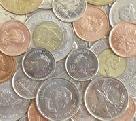
 |
|
| Financial Terms | |
| Turning Point |
|
Information about financial, finance, business, accounting, payroll, inventory, investment, money, inventory control, stock trading, financial advisor, tax advisor, credit.
Main Page: stock trading, accounting, payroll, investment, financial, credit, money, finance, |
Definition of Turning Point
Turning PointThe trough or peak of a business cycle.
Related Terms:Yield curveThe graphical depiction of the relationship between the yield on bonds of the same credit quality Leading IndicatorA variable that reaches a turning point (a peak or a trough) before the economy reaches a turning point. PeakThe upper turning point of a business cycle, where expansion turns into a contraction. TroughThe lower turning point of a business cycle, where a contraction turns into an expansion. Basis pointIn the bond market, the smallest measure used for quoting yields is a basis point. Each percentage Bond pointsA conventional unit of measure for bond prices set at $10 and equivalent to 1% of the $100 face Cash-flow break-even pointThe point below which the firm will need either to obtain additional financing  Delivery pointsThose points designated by futures exchanges at which the financial instrument or PointThe smallest unit of price change quoted or, one one-hundredth of a percent. Related: minimum price Point and figure chartA price-only chart that takes into account only whole integer changes in price, i.e., a Price value of a basis point (PVBP)Also called the dollar value of a basis point, a measure of the change in Breakeven pointThe point at which total costs equal total revenue, i.e. where there is neither a profit nor a loss. breakeven pointThe annual sales volume level at which total contribution Basis PointOne one-hundredth of one percent break-even point (BEP)the level of activity, in units or dollars, at which total revenues equal total costs order pointthe level of inventory that triggers the placement  split-off pointthe point at which the outputs of a joint process are first identifiable or can be separated as individual products Basis pointOne hundredth of one percentage point, or 0.0001. Point and figure chartA financial chart usually used to plot asset price data. Breakeven pointThe sales level at which a company, division, or product line makes a Split-off pointThe point in a production process when clearly identifiable joint costs Basis PointOne one-hundredth of a percentage point, used to express variations in yields. For example, the difference between 5.36 percent and 5.38 percent is 2 basis points. Free-on-Board (FOB) Shipping PointA shipping arrangement agreed to between buyer and Order penetration pointThe point in the production process when a product is Outbound stock pointA designated inventory location on the shop floor between Point-of-use deliveryA delivery of stock to a location in or near the shop floor Point-of-use storageThe storage of stock in a location in or near the shop floor  StockpointAn inventory storage area used for short-term inventory staging. point of sale (POS)The terminal at which a customer uses his/her debit card to make a direct payment transaction. See also Interac Direct Payment. Related to : financial, finance, business, accounting, payroll, inventory, investment, money, inventory control, stock trading, financial advisor, tax advisor, credit. |